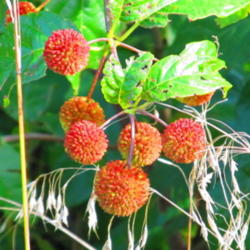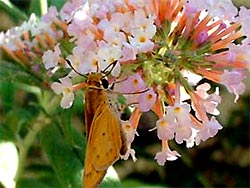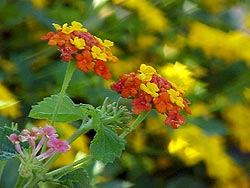
Here are nine other "butterfly" plants recommended by Dr. Art Shapiro, a lepidopterist at the University of California at Davis and a lifelong butterfly gardener.
Buttonbush (Cephalanthus occidentalis): summer-blooming shrub that bears ball-like clusters of 1-inch white flowers; prefers a moist location; 5 to 6 feet in height; hardy to -20°F.
Escallonia Escallonia virgata: salt- and wind-tolerant everg shrub that bears pale rose or white blossoms in late fall or winter; very popular in California; to 6 feet in height; hardy to 15°F.
Germander (Teucrium chamaedrys): drought-tolerant evergreen shrub; good for edging or low, clipped hedge; bears red, purple or white flowers in summer; to 1 foot in height; hardy to -10°F.
Honeysuckle (Lonicera): a large genus of vigorous spring-blooming shrubs that bear sweetly scented flowers in white, pink or yellow, as well as colorful berries; 5 to 15 feet in height; hardy to -40°F.
Lantana (Lantana camara): a fast-growing, profuse bloomer grown outdoors year-round in the South and California, elsewhere grown as an annual; blossoms start yellow, turn to orange and red; to 4 feet in height; hardy to 20°F.
Lavender (Lavandula): a good drought-tolerant hedge or edging with narrow leaves and dense clusters of purple flowers; blooms in summer (and through the winter in mild climates); 1 to 3 feet in height; hardy to 20°F.
Lilac (Syringa vulgaris): the common species of this spring-blooming shrub is an old favorite in the North for its fragrant blossom clusters in white, pink, blue or purple; 10 to 15 feet in height; hardy to -40°F.
Privet (Ligustrum): drought- and wind-tolerant hedge plant with glossy green leaves that bears small white flowers in spring; the waxleaf or Japanese privet (L. japonicum) is especially recommended for California; 5 to 15 feet in height; hardy to -40°F.
Rosemary (Rosmarinus): upright evergreen shrub that's also cultivated as a culinary herb; bears pale blue flowers in fall (and through the winter in mild climates); requires well-drained soil; to 6 feet in height; hardy to 0°F.
Molly Dean's butterfly garden is at her home in Clayton, Georgia.
Photography by Suzanne DeJohn/National Gardening Association

Key to plant descriptions:
Plant Name; Height; Bloom Period; Hardiness
Buddleia davidii; 3 to 20 feet; blooms summer to fall; hardy to -20°F as an herbaceous perennial, to 0°F as a shrub
Of all the shrubs to choose from, the orange eye butterfly bush probably has the most butterfly-drawing power. It is a delight on a summer's day to watch all types of butterflies, from tiny bluesger swallowtails, as they seem to almost drunkenly sip the nectar from the long, clustered flowers. Hummingbirds also make occasional stops, and moths visit, especially in the evening.
This species is called "orange eye" because of the delicate orange edging around the centers of the tiny tubular florets that make up the long blossom clusters. These clusters are quite long, up to 1 1/2 feet in length, and they give off a uniquely sweet, lingering fragrance. Keep the spent clusters deadheaded and this shrub will bloom into the fall.
Flowers of the original shrubs, which are native to China, were blue and mauve. Today, however, there are many different hybrids in pink, magenta, lilac, white and a rich, deep indigo, often described as "blue-black." This cultivar, 'Black Knight', is beautiful and provides visual interest in the garden, but butterflies don't like it as well. The foliage of the orange eye butterfly bush is also handsome. Its long, slender leaves have a soft, silvery look and are slightly fuzzy.
In warm climates, B. davidii can grow to tree size, up to 15 or even 20 feet tall with an equal spread. However, in most areas of the country, it's typically three to eight feet tall. Where winter is severe, cut it back and mulch the crown to protect the roots.
B. davidii needs full sun and thrives in enriched, well-drained soil. It blooms on new wood. Prune in early spring before growth starts to promote flowering.
Buddleia alternifolia; 10 to 20 feet; blooms in late spring to summer; hardy to -20°F as an herbaceous perennial, to -10°F as a shrub
The fountain buddleia (also known as the alternate leaf butterfly bush) has long, arching branches that, when blooming, resemble a lavender fountain. The eight- to 10-foot-long flower spikes resemble those of the lilac and the silvery green foliage brings to mind a willow.
This species blooms earlier than the orange eye butterfly bush its flowers are produced on old growth as opposed to new, so it should be pruned just after flowering to promote even more flowers the next season. Like Buddleia davidii, this species likes lots of sun and rich soil.
Abelia grandiflora; 3 to 6 feet; blooms summer to fall; hardy to -20°F as an herbaceous perennial, to -5°F as a shrub
One of my favorite memories is of watching through my mother's front windows as butterflies covered the Abelia bushes that bloomed against her house. Today I have a single glossy abelia (Abelia grandiflora) in my own garden, and it is visited all summer and even throughout early fall by groups of butterflies, particularly the various swallowtails.
The glossy abelia, a hybrid derived from species native to China, is the most commonly cultivated form. It does particularly well in southern gardens. It is fairly small, not often exceeding five feet, and has small, delicate leaves that are bronze-tinged when young and dark and shiny when mature. The small, tubular flowers are a translucent white with the faintest blush of rose.
Abelia will take sun or partial shade and should be grown in acid soil enriched with peat moss or leaf mold. It is often used as an informal hedge but is equally attractive as a specimen plant.
Caryopteris clandonesis; to 2 feet; blooms summer to fall; hardy to -10° as an herbaceous perennial, to 0° as a shrub
Autumn-blooming shrubs are rare, and so are those having misty blue flowers. Combine these desirable characteristics with the trait of attracting butterflies, and you have Caryopteris.
This genus includes 15 species, all of which come from the Far East. C. clandonensis, commonly known as bluebeard or blue spirea, is the species one usually finds at garden centers and in catalogs. One of its most notable features is its delicate appearance and size.
Its stems are wiry, and its leaves are slender and aromatic, with the same silvery look as those of the butterfly bush. For pastel blue blossoms, choose 'Blue Mist', or for a deep, richer shade, plant 'Dark Knight' or 'Heavenly Blue'. All have a gentle, misty look because of the sheer delicacy of the blossoms.
Caryopteris needs full sun, and a light, well-drained soil. It flowers on new growth, so prune in early spring to ensure heavy flowering.
Wisteria floribunda; 30 feet; blooms in spring; hardy to -20° as a shrub
The large pendulous flower clusters of the wisteria vine are quite appealing to butterflies in late spring. Wisteria can be used in many ways in the garden, as long as its heavy twining woody vine is assured lots of support. Let it climb a tree in a wild garden or cover a pergola or hide a chain-link fence. It can even be trained to grow as a small tree on its own.
Most wisteria species hail from the Orient and did not come to the West until the early 1700s. The richly fragrant Japanese wisteria W. floribunda is a good choice for gardens. Plant named cultivars instead of seedlings -- they are more likely to flower. There is a double lilac blue cultivar, 'Plena', and the highly scented white, 'Ivory Tower'.
Wisteria grows best on fertile, well-drained soil in full sun. Before it flowers, apply a fertilizer that's low in nitrogen and rich in phosphate, such as 5-10-10.
Somewhat slow to get established, wisteria can eventually become a large, sprawling plant that reaches 30 feet or more beyond its designated area. It's sometimes necessary to root prune in early spring. Prune back new shoots in summer to three to four buds to encourage more flowers the next year.

Not long after we moved from our small, shady city lot to a sprawling sunny piece of land in the country, we were rewarded by a visit from a flock of monarch butterflies that stopped to feed at a plot of wild asters. From then on, as we developed our new gardens, we made careful note of which flowers would draw butterflies. Fritillaries came to the coreopsis, tiger swallowtails loved our Rubrum lilies, and both species seemed to enjoy the purple coneflowers. But although there are many annuals and perennials that butterflies find very attractive, in our experience it was the flowering shrubs that proved to be irresistible to them.
Lured by scent and color, butterflies visit certain plants to feed on nectar, a sugary solution containing the carbohydrates that butterflies need for energy. After planting many of the shrubs recommended as butterfly favorites, over the years we found the five plants described below -- four shrubs and one woody vine -- to be the most effective at drawing the widest range of butterflies in large numbers. All of these plants thrive as shrubs in my USDA Hardiness Zone 7 Georgia garden; in colder climates, they survive as herbaceous perennials, dying back to the ground in winter. Keep in mind that a range of early- to late-blooming plants will ensure that the butterflies have food through the season, and a mix of heights will attract both high- and low-flying species.
For me, there's no better way to spend a summer's day than to laze in the sun by our large hedge of Buddleia davidii, a cool drink in one hand and a camera in the other, watching the butterflies.